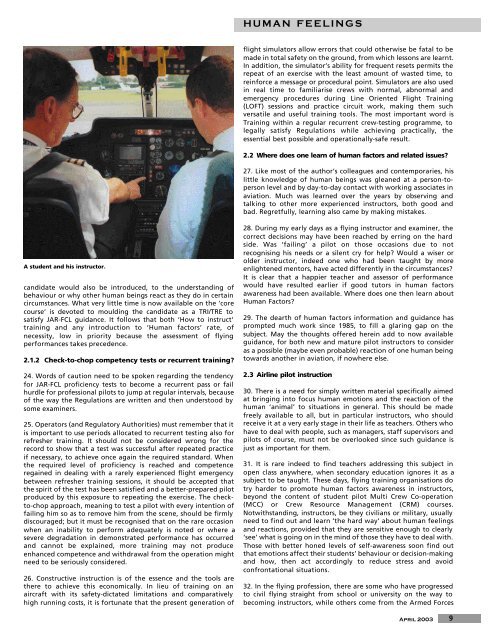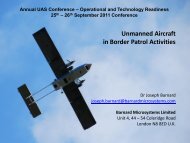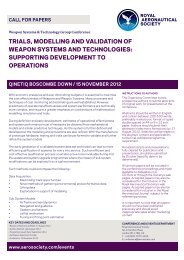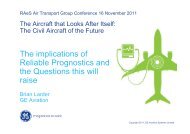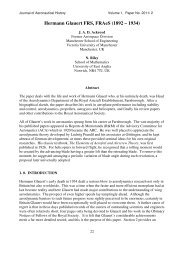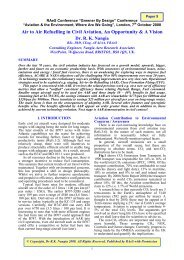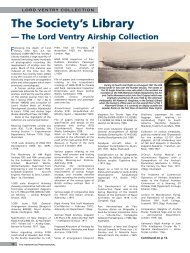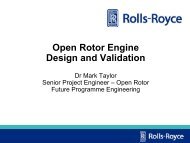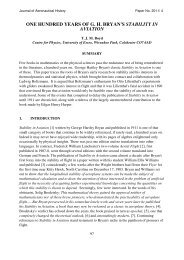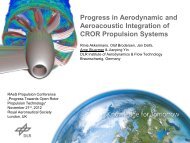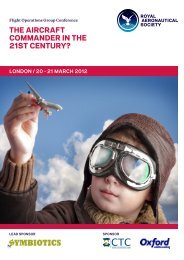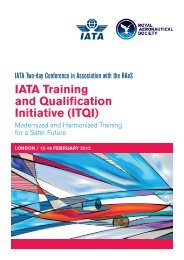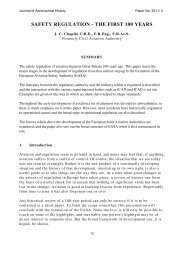The human element in airline training - Royal Aeronautical Society
The human element in airline training - Royal Aeronautical Society
The human element in airline training - Royal Aeronautical Society
Create successful ePaper yourself
Turn your PDF publications into a flip-book with our unique Google optimized e-Paper software.
A student and his <strong>in</strong>structor.<br />
candidate would also be <strong>in</strong>troduced, to the understand<strong>in</strong>g of<br />
behaviour or why other <strong>human</strong> be<strong>in</strong>gs react as they do <strong>in</strong> certa<strong>in</strong><br />
circumstances. What very little time is now available on the ‘core<br />
course’ is devoted to mould<strong>in</strong>g the candidate as a TRI/TRE to<br />
satisfy JAR-FCL guidance. It follows that both ‘How to <strong>in</strong>struct’<br />
tra<strong>in</strong><strong>in</strong>g and any <strong>in</strong>troduction to ‘Human factors’ rate, of<br />
necessity, low <strong>in</strong> priority because the assessment of fly<strong>in</strong>g<br />
performances takes precedence.<br />
2.1.2 Check-to-chop competency tests or recurrent tra<strong>in</strong><strong>in</strong>g?<br />
24. Words of caution need to be spoken regard<strong>in</strong>g the tendency<br />
for JAR-FCL proficiency tests to become a recurrent pass or fail<br />
hurdle for professional pilots to jump at regular <strong>in</strong>tervals, because<br />
of the way the Regulations are written and then understood by<br />
some exam<strong>in</strong>ers.<br />
25. Operators (and Regulatory Authorities) must remember that it<br />
is important to use periods allocated to recurrent test<strong>in</strong>g also for<br />
refresher tra<strong>in</strong><strong>in</strong>g. It should not be considered wrong for the<br />
record to show that a test was successful after repeated practice<br />
if necessary, to achieve once aga<strong>in</strong> the required standard. When<br />
the required level of proficiency is reached and competence<br />
rega<strong>in</strong>ed <strong>in</strong> deal<strong>in</strong>g with a rarely experienced flight emergency<br />
between refresher tra<strong>in</strong><strong>in</strong>g sessions, it should be accepted that<br />
the spirit of the test has been satisfied and a better-prepared pilot<br />
produced by this exposure to repeat<strong>in</strong>g the exercise. <strong>The</strong> checkto-chop<br />
approach, mean<strong>in</strong>g to test a pilot with every <strong>in</strong>tention of<br />
fail<strong>in</strong>g him so as to remove him from the scene, should be firmly<br />
discouraged; but it must be recognised that on the rare occasion<br />
when an <strong>in</strong>ability to perform adequately is noted or where a<br />
severe degradation <strong>in</strong> demonstrated performance has occurred<br />
and cannot be expla<strong>in</strong>ed, more tra<strong>in</strong><strong>in</strong>g may not produce<br />
enhanced competence and withdrawal from the operation might<br />
need to be seriously considered.<br />
26. Constructive <strong>in</strong>struction is of the essence and the tools are<br />
there to achieve this economically. In lieu of tra<strong>in</strong><strong>in</strong>g on an<br />
aircraft with its safety-dictated limitations and comparatively<br />
high runn<strong>in</strong>g costs, it is fortunate that the present generation of<br />
HUMAN FEELINGS<br />
flight simulators allow errors that could otherwise be fatal to be<br />
made <strong>in</strong> total safety on the ground, from which lessons are learnt.<br />
In addition, the simulator’s ability for frequent resets permits the<br />
repeat of an exercise with the least amount of wasted time, to<br />
re<strong>in</strong>force a message or procedural po<strong>in</strong>t. Simulators are also used<br />
<strong>in</strong> real time to familiarise crews with normal, abnormal and<br />
emergency procedures dur<strong>in</strong>g L<strong>in</strong>e Oriented Flight Tra<strong>in</strong><strong>in</strong>g<br />
(LOFT) sessions and practice circuit work, mak<strong>in</strong>g them such<br />
versatile and useful tra<strong>in</strong><strong>in</strong>g tools. <strong>The</strong> most important word is<br />
Tra<strong>in</strong><strong>in</strong>g with<strong>in</strong> a regular recurrent crew-test<strong>in</strong>g programme, to<br />
legally satisfy Regulations while achiev<strong>in</strong>g practically, the<br />
essential best possible and operationally-safe result.<br />
2.2 Where does one learn of <strong>human</strong> factors and related issues?<br />
27. Like most of the author’s colleagues and contemporaries, his<br />
little knowledge of <strong>human</strong> be<strong>in</strong>gs was gleaned at a person-toperson<br />
level and by day-to-day contact with work<strong>in</strong>g associates <strong>in</strong><br />
aviation. Much was learned over the years by observ<strong>in</strong>g and<br />
talk<strong>in</strong>g to other more experienced <strong>in</strong>structors, both good and<br />
bad. Regretfully, learn<strong>in</strong>g also came by mak<strong>in</strong>g mistakes.<br />
28. Dur<strong>in</strong>g my early days as a fly<strong>in</strong>g <strong>in</strong>structor and exam<strong>in</strong>er, the<br />
correct decisions may have been reached by err<strong>in</strong>g on the hard<br />
side. Was ‘fail<strong>in</strong>g’ a pilot on those occasions due to not<br />
recognis<strong>in</strong>g his needs or a silent cry for help? Would a wiser or<br />
older <strong>in</strong>structor, <strong>in</strong>deed one who had been taught by more<br />
enlightened mentors, have acted differently <strong>in</strong> the circumstances?<br />
It is clear that a happier teacher and assessor of performance<br />
would have resulted earlier if good tutors <strong>in</strong> <strong>human</strong> factors<br />
awareness had been available. Where does one then learn about<br />
Human Factors?<br />
29. <strong>The</strong> dearth of <strong>human</strong> factors <strong>in</strong>formation and guidance has<br />
prompted much work s<strong>in</strong>ce 1985, to fill a glar<strong>in</strong>g gap on the<br />
subject. May the thoughts offered here<strong>in</strong> add to now available<br />
guidance, for both new and mature pilot <strong>in</strong>structors to consider<br />
as a possible (maybe even probable) reaction of one <strong>human</strong> be<strong>in</strong>g<br />
towards another <strong>in</strong> aviation, if nowhere else.<br />
2.3 Airl<strong>in</strong>e pilot <strong>in</strong>struction<br />
30. <strong>The</strong>re is a need for simply written material specifically aimed<br />
at br<strong>in</strong>g<strong>in</strong>g <strong>in</strong>to focus <strong>human</strong> emotions and the reaction of the<br />
<strong>human</strong> ‘animal’ to situations <strong>in</strong> general. This should be made<br />
freely available to all, but <strong>in</strong> particular <strong>in</strong>structors, who should<br />
receive it at a very early stage <strong>in</strong> their life as teachers. Others who<br />
have to deal with people, such as managers, staff supervisors and<br />
pilots of course, must not be overlooked s<strong>in</strong>ce such guidance is<br />
just as important for them.<br />
31. It is rare <strong>in</strong>deed to f<strong>in</strong>d teachers address<strong>in</strong>g this subject <strong>in</strong><br />
open class anywhere, when secondary education ignores it as a<br />
subject to be taught. <strong>The</strong>se days, fly<strong>in</strong>g tra<strong>in</strong><strong>in</strong>g organisations do<br />
try harder to promote <strong>human</strong> factors awareness <strong>in</strong> <strong>in</strong>structors,<br />
beyond the content of student pilot Multi Crew Co-operation<br />
(MCC) or Crew Resource Management (CRM) courses.<br />
Notwithstand<strong>in</strong>g, <strong>in</strong>structors, be they civilians or military, usually<br />
need to f<strong>in</strong>d out and learn ‘the hard way’ about <strong>human</strong> feel<strong>in</strong>gs<br />
and reactions, provided that they are sensitive enough to clearly<br />
‘see’ what is go<strong>in</strong>g on <strong>in</strong> the m<strong>in</strong>d of those they have to deal with.<br />
Those with better honed levels of self-awareness soon f<strong>in</strong>d out<br />
that emotions affect their students’ behaviour or decision-mak<strong>in</strong>g<br />
and how, then act accord<strong>in</strong>gly to reduce stress and avoid<br />
confrontational situations.<br />
32. In the fly<strong>in</strong>g profession, there are some who have progressed<br />
to civil fly<strong>in</strong>g straight from school or university on the way to<br />
becom<strong>in</strong>g <strong>in</strong>structors, while others come from the Armed Forces<br />
April 2003<br />
9


